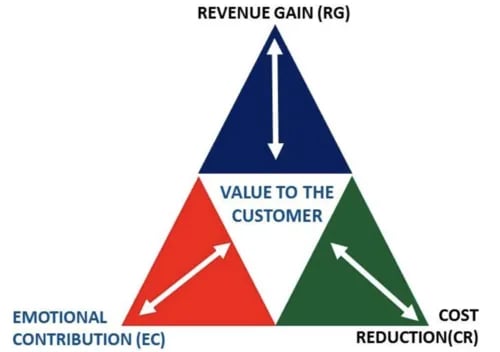This blog post is based on a podcast episode of The Sales Ladder. You can listen to the whole episode below.
What is value
There are many definitions of what value, and value selling, is.
Take HubSpot’s, for example. According to them, the aim is “to provide value to the customer so the sales decision is made based on the potential value the product can provide.”
Or sales legend Brian Tracy’s: “With this approach, the sales conversation focuses on how the buyer’s life will be improved with the asset at hand.”
Product. Asset.
The problem with these definitions is that they are based on assumptions that value is based purely on the benefit the product will bring to the customer.
They fail to realize the most important thing: value is defined by your customer, not you.
So, what is value, then?
Value is a mystery.
Value triad
The value triad is a concept that identifies the three key component areas of value
The first component is revenue or performance gains. In other words, how does your product or service help your customers improve their revenue or performance? It’s important to keep the performance aspect as revenue might not be the issue for all your customers. For example, a hospital might focus on patient outcomes.
The second element is cost reduction. How does your product or service help your customer to reduce their cost?
The third component is emotional contribution. This element focuses on relationships, and your credibility or reputation in the eyes of your customers that will enable you to build trust (or not).
These three components interconnect to create the value triad. In a sales situation, you want to understand the elements of value that are important to the prospect, and flex your value model to put the right level of ingredients from revenue gain, cost reduction, and emotional contribution.
 (Source)
(Source)
So, to recap so far.
Value is a mystery. And as a detective, you need three things in your toolkit:
- Revenue/performance gains
- Cost reduction
- Emotional contribution
The 7 mistakes of value selling
There are many mistakes
- Discount Default
Procurement will always tell suppliers they are too expensive because they have learned from experience that a supplier’s first reaction to such a statement is to drop the price.
Getting out of the discount default mentality is tough. As a sales agent, you need confidence to look a prospect in the eye (face to face or via video calls) and say, “no, we are not too expensive, in fact, we’re probably not expensive enough for the value we deliver.”
One of the most difficult things to build that confidence is being able to communicate value effectively. If you cannot do that, you will almost always resort to discounting. - Believing product is a commodity
Customers don’t simply buy your product, they buy the entire purchasing experience. The product itself is only a part of it.
If you cannot differentiate through your product, then you have to look at how you can differentiate in other areas of the business.
Every single individual in an organization plays a part in adding value to the experience, be it service delivery, support, onboarding etc... - Focusing on presenting your product first rather than understanding the customer first
Too many sales calls begin with the seller launching straight into a presentation about their products without actually understanding what the customer wants.
A lot of organizations claim their product or service is a solution. Remember, then, that a solution is the answer to a problem.
If you don’t understand the customer’s problem, you do not have a solution.
As Tony Allasandra said, “prescription before diagnosis is malpractice.” - Failing to solve the value mystery
Failing to solve that mystery is unfortunately a common mistake. In order to solve it, it is important to realize that your customers define value, not you.
There are 4 key steps to follow in a value selling process
Quality assessment
Don’t invest time, money and effort pursuing prospects that have no chance of converting. You want to ensure you have good quality opportunities going into your sales pipeline.
Ensure the prospect falls within your ICPs and that you are discussing with decision makers with a budget.
Value discovery
This is the phase in which you need to understand the issues your prospects face. What are their challenges, problems, opportunities they have?
What are the pains and gains, and the impact on their business of failing to address them or taking advantage of them?
It’s important to understand the difference between pain and gain.
Pain is away from motivation. it's when you've got a big problem that you have to solve, it introduces a degree of urgency. It's the catalyst to change.
Gain is towards motivation. It's the thing that keeps you going, it’s what will get your prospect to the promise.
There is a last part to the value discovery phase, which is often overlooked, and one of the big reasons that you never got commitment from the customer. that they needed to do something.
The number one thing you need to do is to be able to summarize back to the customer your understanding of the problems, the issues, the challenges that they face, the impact of those issues on their business, the potential gains they will get by addressing them and a commitment from them that they think it is something they need to do something about it.
Value demonstration
The opportunity for you to demonstrate that your solution does what the customer wants done. There are many ways to demonstrate value, but it needs to be done through a value proposition.
There are three things your value proposition should do:
- It needs to resonate with the customer. Having identified the challenges, issues, and problems they face, your value proposition needs to demonstrate that you will address each of them
- Your value proposition should differentiate. Costumers need to look at your solution and feel no other really tick all the boxes quite like yours.
- You have to be able to substantiate. You need to prove that you can deliver what you promise to deliver so the buyer sees a reduction in the risk they are taking by coming with you.
Value delivery
Once you’ve acquired the customer, you need to deliver on the value promise. Keeping in mind that it’s 7 times more expensive to acquire new customers than to retain existing ones, there are good reasons to focus on retention. - Thinking that it’s all about the sales team
Value based selling is a team effort. As mentioned in some segments above, everyone - both as an organisation and individually - contributes to providing value to customers, regardless of their position in the organisation.
This means that everyone needs to understand, create, and deliver customer value. - Failing to communicate and capture your value
Customers do not buy what your products are, but the solution they fix. Nobody wants a drill; what they want is the hole.
Learn how to communicate the value of your product or service not in terms of features, but the actual benefits to the customers. - Not having an agreed sales process
Customers will always have objections. The easiest way to learn how to handle objections is having a sales process that you can follow. There's also the fact that having a sales process can help increase revenue by up to 28%.
However, a sales process is never set in stone. one of the benefits of having a sales process is that you can interrogate it as things change, and you can constantly look at each of the steps and say, is this still doing what I needed? And if it isn't, then you should be finessing it and changing it.
In fact, your sales process itself could be a place where you can differentiate and add value. As customer journeys become hyper-personalised, complex matrixes, utilising a concept like a digital sales room could be an opportunity to revamp your process, lock in prospects, and differentiate from the competition.
Let’s stay in touch!
Subscribe to GetAccept’s monthly newsletter packed with sales trends and tips, product releases, invitations to special events and webinars — and more! Zero spam. Unsubscribe at any time.



